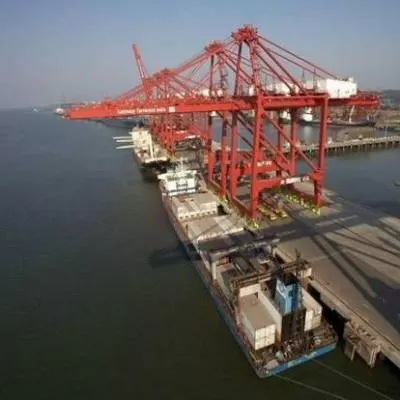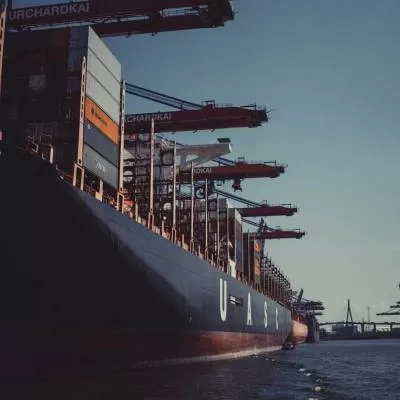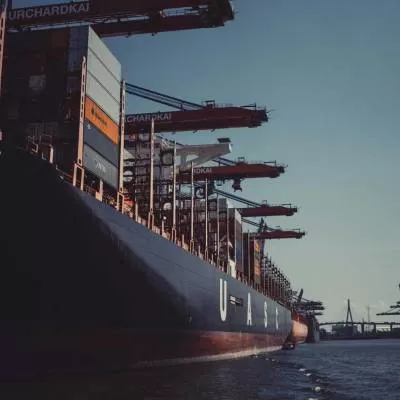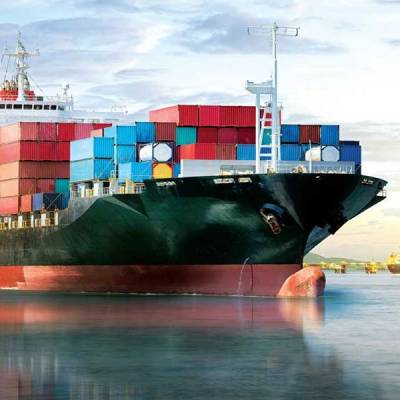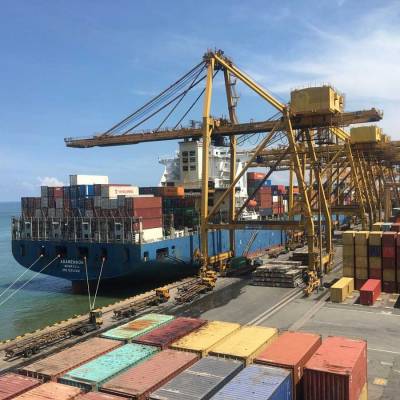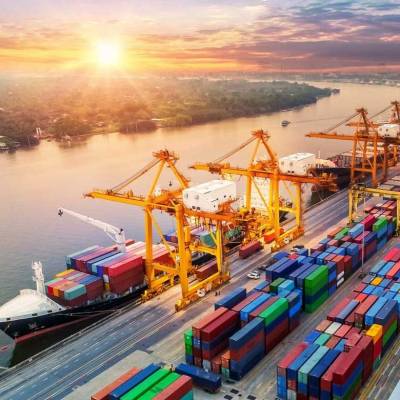- Home
- Infrastructure Transport
- PORTS & SHIPPING
- The hardcore professional
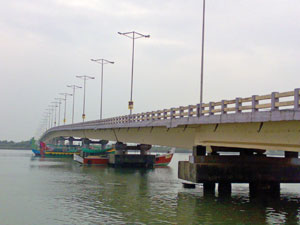
The hardcore professional
"I like hardcore engineering and that's why I am purely an engineer even at this age," says Dr Ir PV Chandramohan, President-Technical, Navayuga Engineering Company Ltd. "I resisted being a manager all my life as I felt management would have wiped out the engineer in me. I have seen it happen to many engineers." Perhaps a loss to the management field but no doubt a huge gain to civil engineering and the construction industry. In a career spanning over four decades in the ports sector, this 66-year-old has designed and developed some remarkable structures, introduced many innovations, developed software programmes and published technical papers aplenty.
For all his passion and dedication to his profession, it was not a career chosen by design. A maternal uncle whom Dr Chandramohan never met indirectly influenced his career choice. "My uncle had to go all the way to Guindy Engineering College in Chennai as there were no engineering colleges in Kerala then," reveals Dr Chandramohan. "After graduation, he barely worked for six months before dying of malnutrition. It was a sad loss for a poor family as others were not very educated. They then took a vow that the first child in the next generation would be made an engineer. The mantle fell on me!" Likewise, his career in the ports sector was also not planned though he had a penchant for ports, having been born and brought up in Kochi, a port city. "The port was located in an island across the backwaters. My father used to take me to the waterfront and show me the harbour lights across the basin. This created a longing in me to access those faraway lights," says Dr Chandramohan, who did reach out to those lights when he joined Cochin Port Trust (CPT) after his graduation.
Although basically a designer, he has always made it a point to visit every site and be a part of the execution process. "To see my design concept shape into a concrete object gives me intense satisfaction and joy," says Dr Chandramohan, who has designed and built structures ranging from bridges, buildings and foundations to lift irrigation, breakwaters, cofferdam, jetties, berths and slipways. He also has many firsts to his credit; the latest being the design of a structural breakwater and post-tensioned diaphragm wall for berthing structures in Machilipatnam Port. Dr Chandramohan's dream is to see the design, the first-of-its-kind in the world, take shape. His personal favourite, though, is the Goshree project. He tells us why, and shares his experience and views on civil and port engineering with CW...
Pet project
Goshree Bridges was a challenging assignment involving engineering, financial, legal and social issues. Cochin's backwaters are dotted with many islands. Three islands on the northern side - Bolghatty, Vallarpadam and Vypeen - were not connected to the mainland then. The locals had to travel by boat to the mainland for their livelihood, which was cumbersome and hazardous during the monsoon. It was their long cherished dream to be connected to the Ernakulam mainland via bridges. I was on deputation to the state government to handle the project, which was riddled with problems. First, the state government did not have the funds to build the bridges. Poor response to the prequalification bid revealed that the construction companies were not keen on investing in the project either. Meanwhile, the environmentalists had filed a case in the court opposing the project. But I did not want to let it go because I knew many people in the islands were waiting for the bridges.
The specs
Here, the core project was the bridges and the supporting project was the land reclamation, from the sale of which the core project had to be funded. I realised that the core project cost should be kept to a minimum to reduce the total cost. While analysing the project, I also tried to figure out why the project cost amounted to Rs 507 crore, when the cost of constructing the bridges was only Rs 180 crore. Vypeen was on the west of the Ernakulam mainland. But instead of going directly to the west, the proposed first bridge was aligned to the north, which had increased the cost. This was done because the major reclamation was to be around Thanthonni Island on the north, which had to be connected for yielding high land prices. So I shifted the site of reclamation to Ernakulam's Marine Drive where the unit price of land was high but it cut down the extent of reclamation drastically. The reclaimed land here did not require a bridge connection, which reduced the number of bridges to three. Then, I saw that the waterway between Ernakulam and Thanthonni reclamation was only 180 m but the crossing was via a 550-m-long bridge because of the marine drives, which were being over-passed. So the marine drives were dispensed with and four-lane bridges were reduced to two lanes as it was sufficient for the traffic envisaged. All these changes brought down the cost to Rs 84 crore from Rs 507 crore. This was a civil engineering solution to a financial problem.
Engineering essentials
The ability to develop concepts is the prime requirement of a design engineer. He should be able to visualise how the forces act and reactions develop. The concept cannot be studied but it develops while studying engineering. A designer should be open to learning other subjects regardless of his speciality. He should keep updating his knowledge and have the confidence and courage to go ahead with any structure. Those working at site should be able to anticipate the difficulties of executing a project. Theoretical knowledge is necessary to be a good site engineer. For example, there are highly involved computations in post and pre-tensioned concrete. Those who know the theory of pre-stressing will be able to understand what happens inside the structure when stressing of tendons is carried out. They will be prepared for sudden eventualities. Life at site is tough as one is open to the vagaries of nature and living conditions are far from comfortable. Civil engineering as a whole is tough, but also rewarding.
Port proficiency
Construction work at ports is linked to marine conditions. Port waters are tidal and construction operations are exposed to violent wave action. Marine structures come in contact with corrosive saline water and have to bear the impact of the vessel during berthing. Hence, carrying out construction in such an environment requires tenacity and aptitude. At present, we are expanding the thresholds of port engineering. A port grows downwards as bigger and bigger ships go deeper and deeper. This implies that the channels and berths in ports should cater to deeper draughts. In India, many modern ports are designed to a draught of 20 m. Many of our ports are also marching forward in other areas of port development and infrastructure. However, our shortcoming is in the field of machinery. For example, we are executing massive piling and diaphragm wall works. But piling rigs and trench cutters are being imported. For dredging to deep depths, dredgers have to come from outside. This is true with all required machinery.
Software source
Programmes are developed by software companies for commercial use. So it is viable for them only if the customer base is large. In the case of engineering designs, the customer base is comparatively small. If the designs are of a special nature, there are no readymade programmes available. This prompted me to develop my own programmes for special applications. But later on, I tried common programmes. These are applicable in the design of pre-stressed and segmental bridges, bridge piers/piles, hydropower and lift irrigation projects, anchored and cantilever diaphragm walls, breakwaters, etc
TRACK RECORD: Dr PV Chandramohan
Academic
• Bachelor of Science (Civil Engineering), University of Kerala (1967)• Postgraduate Diploma in Dock and Harbour Engineering, Indian Institute of Technology-Bombay (1977)
• Postgraduate Diploma in Hydraulic Engineering (Coastal Engineering, Port Planning and Design), International Institute for Hydraulic and Environmental Engineering, Delft, Netherlands (1987)
• Master of Science in Hydraulic Engineering, International Institute for Hydraulic and Environmental Engineering, Delft, Netherlands (1989)
• Doctor of Philosophy, Indian Institute of Technology-Bombay (1996)
Professional
• 1968-2002: Cochin Port Trust, Joined as Junior Engineer and moved up the ladder to become Superintending Engineer in 2001
• 1996-2002: Project Director, Goshree Island Development Authority
• 2002-2004: Chief Engineer, Kandla Port Trust
• 2004-2006: Consultant
• 2006 to date: President-Technical, Navayuga Engineering Company Ltd, Hyderabad
• Member of Institution of Engineers, Indian Road Congress, Indian Society for Hydraulics and Indian Institution of Bridge Engineers
• Over 105 papers presented/published in national/international conferences and journals
• Developed a concrete armour block for use in breakwaters and coastal protection (Patent for the invention is pending)
• Developed several software programmes for designing various types of bridges, marine structures, tunnels, canals, etc.
Awards
• National Award for the Design of Most Outstanding Bridge from Indian Institution of Bridge Engineers (1996)
• Nominated for Person of the Year 2007 Award by Indiavision Channel
• Award for Most Outstanding Bridge 2008 for formulating the self-supporting Goshree Project from Indian Institution of Bridge Engineers
Challenging Projects
Project 1
Project: Goshree, Kochi (Kerala)
Period: 1999-2004
Cost: Rs 84 crore
Client: Goshree Islands Development Authority (GIDA)
Contractor: Land reclamation by ABC & Sons; bridges and roads by Afcons Infrastructure Ltd
Background: The project involved the reclamation of 25 hectare from the backwaters, the construction of three bridges connecting the islands of Bolghatty, Vallarpadam and Vypeen, and building roads.
Unique features: As the government did not have funds, the project was formulated as a self-supporting one. "A small stretch of land on the mainland was reclaimed and the bridges were built by the funds raised from the sale of the reclaimed land," says Dr Chandramohan. "It was a great success as the earnings from the land sale were more than the amount spent on the bridges." Some unique methods of execution were employed too. As three bridges were involved, and the distance from the worksite at Ernakulam was long, a floating batching plant was used. The box girders were precast over the specially prepared piled bed. Two load-in jetties on piles were constructed in the water perpendicular to the casting yard. The girders were side transferred by sliding on to these jetties. "Launching of the girders was done by a novel method called float-launching," explains Dr Chandramohan. "A specially designed floating crane would come in between the jetties. The girder was lifted up by the crane and floated on to the required location. The box girder was then lowered on to the bearings on the pedestals."
Challenges: The main challenge was winning the legal battle with the environmentalists who opposed the bridges. Land acquisition was another challenge. The islanders wanted the bridges but some of them had to vacate for their sake. "The technical challenge was that the piles in the soft clay had low capacity," adds Dr Chandramohan. "So piles had to go very deep into the stratum. In some cases, the piles went down to a level of û68, from a cut-off level of +1.2 m."
Award: The project won the 'Most Outstanding Bridge Award' from the Indian Institution of Bridge Engineers.
Project 2
Project: Rajiv Lift Irrigation Project, Kothakota, Andhra Pradesh
Period: 2006-2011
Cost: Rs 390 crore
Client: Government of Andhra Pradesh
Contractor: Navayuga Engineering Company
Background: The project consisted of drilling a 5-m-diameter tunnel through rock, excavating surge pool and pump house 50 m deep into rock, installing large diameter delivery mains and cistern for energy dissipation
Unique features: It involved a great deal of hydraulic design such as design of a tunnel, surge pool, delivery mains and cistern and tunnelling through the rock for 1.7 km and risky rock excavation.
Project 2
Project: Rajiv Lift Irrigation Project, Kothakota, Andhra Pradesh
Period: 2006-2011
Cost: Rs 390 crore
Client: Government of Andhra Pradesh
Contractor: Navayuga Engineering Company
Background: The project consisted of drilling a 5-m-diameter tunnel through rock, excavating surge pool and pump house 50 m deep into rock, installing large diameter delivery mains and cistern for energy dissipation.
Unique features: It involved a great deal of hydraulic design such as design of a tunnel, surge pool, delivery mains and cistern and tunnelling through the rock for 1.7 km and risky rock excavation.
Challenges: Tunnelling in rock is risky as the rock keeps falling during excavation.
This job was done judiciously with rock bolts and anchors. The excavation presented some unpleasant surprises. The rock stratum was anything but continuous. “As the work on the ramp before the ‘adit’ proceeded, the rock stratum at that depth suddenly ceased to exist,” elaborates Dr Chandramohan. “So the excavation was set off in another direction after retracing some distance. More than any reasoning, hope was our only guide.” One cycle including marking, drilling, loading, blasting, de-fuming and scaling lasted nine hours. The progress achieved during one cycle was about 2 m. Another difficult excavation was that of the delivery mains. The major portion was inclined at 45o. Blasting and removing the muck through a 45o shaft required a special kind of plant. “A hauling plant was specially designed and assembled at site,” he adds. “Initially, mucking was done from the top manually. Later, rails were laid in the tunnel and muck was carried in trolleys hauled by a 5 tonne winch. Mobilisation of the right machinery and coordination between various activities were the keys to the successful execution of the project.”
In the next in a series of interviews with prominent civil engineers, Janaki Krishnmoorthi meets Dr Ir PV Chandramohan, President-Technical, Navayuga Engineering Company Ltd. "I like hardcore engineering and that's why I am purely an engineer even at this age," says Dr Ir PV Chandramohan, President-Technical, Navayuga Engineering Company Ltd. "I resisted being a manager all my life as I felt management would have wiped out the engineer in me. I have seen it happen to many engineers." Perhaps a loss to the management field but no doubt a huge gain to civil engineering and the construction industry. In a career spanning over four decades in the ports sector, this 66-year-old has designed and developed some remarkable structures, introduced many innovations, developed software programmes and published technical papers aplenty. For all his passion and dedication to his profession, it was not a career chosen by design. A maternal uncle whom Dr Chandramohan never met indirectly influenced his career choice. "My uncle had to go all the way to Guindy Engineering College in Chennai as there were no engineering colleges in Kerala then," reveals Dr Chandramohan. "After graduation, he barely worked for six months before dying of malnutrition. It was a sad loss for a poor family as others were not very educated. They then took a vow that the first child in the next generation would be made an engineer. The mantle fell on me!" Likewise, his career in the ports sector was also not planned though he had a penchant for ports, having been born and brought up in Kochi, a port city. "The port was located in an island across the backwaters. My father used to take me to the waterfront and show me the harbour lights across the basin. This created a longing in me to access those faraway lights," says Dr Chandramohan, who did reach out to those lights when he joined Cochin Port Trust (CPT) after his graduation. Although basically a designer, he has always made it a point to visit every site and be a part of the execution process. "To see my design concept shape into a concrete object gives me intense satisfaction and joy," says Dr Chandramohan, who has designed and built structures ranging from bridges, buildings and foundations to lift irrigation, breakwaters, cofferdam, jetties, berths and slipways. He also has many firsts to his credit; the latest being the design of a structural breakwater and post-tensioned diaphragm wall for berthing structures in Machilipatnam Port. Dr Chandramohan's dream is to see the design, the first-of-its-kind in the world, take shape. His personal favourite, though, is the Goshree project. He tells us why, and shares his experience and views on civil and port engineering with CW... Pet project Goshree Bridges was a challenging assignment involving engineering, financial, legal and social issues. Cochin's backwaters are dotted with many islands. Three islands on the northern side - Bolghatty, Vallarpadam and Vypeen - were not connected to the mainland then. The locals had to travel by boat to the mainland for their livelihood, which was cumbersome and hazardous during the monsoon. It was their long cherished dream to be connected to the Ernakulam mainland via bridges. I was on deputation to the state government to handle the project, which was riddled with problems. First, the state government did not have the funds to build the bridges. Poor response to the prequalification bid revealed that the construction companies were not keen on investing in the project either. Meanwhile, the environmentalists had filed a case in the court opposing the project. But I did not want to let it go because I knew many people in the islands were waiting for the bridges. The specs Here, the core project was the bridges and the supporting project was the land reclamation, from the sale of which the core project had to be funded. I realised that the core project cost should be kept to a minimum to reduce the total cost. While analysing the project, I also tried to figure out why the project cost amounted to Rs 507 crore, when the cost of constructing the bridges was only Rs 180 crore. Vypeen was on the west of the Ernakulam mainland. But instead of going directly to the west, the proposed first bridge was aligned to the north, which had increased the cost. This was done because the major reclamation was to be around Thanthonni Island on the north, which had to be connected for yielding high land prices. So I shifted the site of reclamation to Ernakulam's Marine Drive where the unit price of land was high but it cut down the extent of reclamation drastically. The reclaimed land here did not require a bridge connection, which reduced the number of bridges to three. Then, I saw that the waterway between Ernakulam and Thanthonni reclamation was only 180 m but the crossing was via a 550-m-long bridge because of the marine drives, which were being over-passed. So the marine drives were dispensed with and four-lane bridges were reduced to two lanes as it was sufficient for the traffic envisaged. All these changes brought down the cost to Rs 84 crore from Rs 507 crore. This was a civil engineering solution to a financial problem. Engineering essentials The ability to develop concepts is the prime requirement of a design engineer. He should be able to visualise how the forces act and reactions develop. The concept cannot be studied but it develops while studying engineering. A designer should be open to learning other subjects regardless of his speciality. He should keep updating his knowledge and have the confidence and courage to go ahead with any structure. Those working at site should be able to anticipate the difficulties of executing a project. Theoretical knowledge is necessary to be a good site engineer. For example, there are highly involved computations in post and pre-tensioned concrete. Those who know the theory of pre-stressing will be able to understand what happens inside the structure when stressing of tendons is carried out. They will be prepared for sudden eventualities. Life at site is tough as one is open to the vagaries of nature and living conditions are far from comfortable. Civil engineering as a whole is tough, but also rewarding. Port proficiency Construction work at ports is linked to marine conditions. Port waters are tidal and construction operations are exposed to violent wave action. Marine structures come in contact with corrosive saline water and have to bear the impact of the vessel during berthing. Hence, carrying out construction in such an environment requires tenacity and aptitude. At present, we are expanding the thresholds of port engineering. A port grows downwards as bigger and bigger ships go deeper and deeper. This implies that the channels and berths in ports should cater to deeper draughts. In India, many modern ports are designed to a draught of 20 m. Many of our ports are also marching forward in other areas of port development and infrastructure. However, our shortcoming is in the field of machinery. For example, we are executing massive piling and diaphragm wall works. But piling rigs and trench cutters are being imported. For dredging to deep depths, dredgers have to come from outside. This is true with all required machinery. Software source Programmes are developed by software companies for commercial use. So it is viable for them only if the customer base is large. In the case of engineering designs, the customer base is comparatively small. If the designs are of a special nature, there are no readymade programmes available. This prompted me to develop my own programmes for special applications. But later on, I tried common programmes. These are applicable in the design of pre-stressed and segmental bridges, bridge piers/piles, hydropower and lift irrigation projects, anchored and cantilever diaphragm walls, breakwaters, etc TRACK RECORD: Dr PV Chandramohan Academic • Bachelor of Science (Civil Engineering), University of Kerala (1967)• Postgraduate Diploma in Dock and Harbour Engineering, Indian Institute of Technology-Bombay (1977) • Postgraduate Diploma in Hydraulic Engineering (Coastal Engineering, Port Planning and Design), International Institute for Hydraulic and Environmental Engineering, Delft, Netherlands (1987) • Master of Science in Hydraulic Engineering, International Institute for Hydraulic and Environmental Engineering, Delft, Netherlands (1989) • Doctor of Philosophy, Indian Institute of Technology-Bombay (1996) Professional • 1968-2002: Cochin Port Trust, Joined as Junior Engineer and moved up the ladder to become Superintending Engineer in 2001 • 1996-2002: Project Director, Goshree Island Development Authority • 2002-2004: Chief Engineer, Kandla Port Trust • 2004-2006: Consultant • 2006 to date: President-Technical, Navayuga Engineering Company Ltd, Hyderabad • Member of Institution of Engineers, Indian Road Congress, Indian Society for Hydraulics and Indian Institution of Bridge Engineers • Over 105 papers presented/published in national/international conferences and journals • Developed a concrete armour block for use in breakwaters and coastal protection (Patent for the invention is pending) • Developed several software programmes for designing various types of bridges, marine structures, tunnels, canals, etc. Awards • National Award for the Design of Most Outstanding Bridge from Indian Institution of Bridge Engineers (1996) • Nominated for Person of the Year 2007 Award by Indiavision Channel • Award for Most Outstanding Bridge 2008 for formulating the self-supporting Goshree Project from Indian Institution of Bridge Engineers Challenging Projects Project 1 Project: Goshree, Kochi (Kerala) Period: 1999-2004 Cost: Rs 84 crore Client: Goshree Islands Development Authority (GIDA) Contractor: Land reclamation by ABC & Sons; bridges and roads by Afcons Infrastructure Ltd Background: The project involved the reclamation of 25 hectare from the backwaters, the construction of three bridges connecting the islands of Bolghatty, Vallarpadam and Vypeen, and building roads. Unique features: As the government did not have funds, the project was formulated as a self-supporting one. "A small stretch of land on the mainland was reclaimed and the bridges were built by the funds raised from the sale of the reclaimed land," says Dr Chandramohan. "It was a great success as the earnings from the land sale were more than the amount spent on the bridges." Some unique methods of execution were employed too. As three bridges were involved, and the distance from the worksite at Ernakulam was long, a floating batching plant was used. The box girders were precast over the specially prepared piled bed. Two load-in jetties on piles were constructed in the water perpendicular to the casting yard. The girders were side transferred by sliding on to these jetties. "Launching of the girders was done by a novel method called float-launching," explains Dr Chandramohan. "A specially designed floating crane would come in between the jetties. The girder was lifted up by the crane and floated on to the required location. The box girder was then lowered on to the bearings on the pedestals." Challenges: The main challenge was winning the legal battle with the environmentalists who opposed the bridges. Land acquisition was another challenge. The islanders wanted the bridges but some of them had to vacate for their sake. "The technical challenge was that the piles in the soft clay had low capacity," adds Dr Chandramohan. "So piles had to go very deep into the stratum. In some cases, the piles went down to a level of û68, from a cut-off level of +1.2 m." Award: The project won the 'Most Outstanding Bridge Award' from the Indian Institution of Bridge Engineers. Project 2 Project: Rajiv Lift Irrigation Project, Kothakota, Andhra Pradesh Period: 2006-2011 Cost: Rs 390 crore Client: Government of Andhra Pradesh Contractor: Navayuga Engineering Company Background: The project consisted of drilling a 5-m-diameter tunnel through rock, excavating surge pool and pump house 50 m deep into rock, installing large diameter delivery mains and cistern for energy dissipation Unique features: It involved a great deal of hydraulic design such as design of a tunnel, surge pool, delivery mains and cistern and tunnelling through the rock for 1.7 km and risky rock excavation. Project 2 Project: Rajiv Lift Irrigation Project, Kothakota, Andhra Pradesh Period: 2006-2011 Cost: Rs 390 crore Client: Government of Andhra Pradesh Contractor: Navayuga Engineering Company Background: The project consisted of drilling a 5-m-diameter tunnel through rock, excavating surge pool and pump house 50 m deep into rock, installing large diameter delivery mains and cistern for energy dissipation. Unique features: It involved a great deal of hydraulic design such as design of a tunnel, surge pool, delivery mains and cistern and tunnelling through the rock for 1.7 km and risky rock excavation. Challenges: Tunnelling in rock is risky as the rock keeps falling during excavation. This job was done judiciously with rock bolts and anchors. The excavation presented some unpleasant surprises. The rock stratum was anything but continuous. “As the work on the ramp before the ‘adit’ proceeded, the rock stratum at that depth suddenly ceased to exist,” elaborates Dr Chandramohan. “So the excavation was set off in another direction after retracing some distance. More than any reasoning, hope was our only guide.” One cycle including marking, drilling, loading, blasting, de-fuming and scaling lasted nine hours. The progress achieved during one cycle was about 2 m. Another difficult excavation was that of the delivery mains. The major portion was inclined at 45o. Blasting and removing the muck through a 45o shaft required a special kind of plant. “A hauling plant was specially designed and assembled at site,” he adds. “Initially, mucking was done from the top manually. Later, rails were laid in the tunnel and muck was carried in trolleys hauled by a 5 tonne winch. Mobilisation of the right machinery and coordination between various activities were the keys to the successful execution of the project.”


